Has your dog or puppy got into the naughty habit of unnecessarily pulling on the leash while going for his daily walk? Most untrained dogs do, so there is nothing to worry about. To correct that behavior, you will simply need to teach your dog leash training.
Leash training teaches your dog to walk on a loose leash in a calm and well-socialized manner. The main goal of leash training is to avoid having an unruly dog pull you around when he is distracted by outside stimuli like birds, small animals, or even your neighbor walking her dog.
How to Teach Your Dog Leash Walking
In this article, we are going to discuss the verbal cues and the necessary equipment that you will need before you begin training. We will also talk about the 4 main stages of training your dog to walk on a loose leash. We highly recommend that you work through the 4 stages in the order that they appear (from 1-4), to get the best results.
- Stage 1 – Turning Around in a Circle
- Stage 2 – The “Hold Your Ground” Challenge
- Stage 3 – Walking in a Straight Line and Backing Up
- Stage 4 – Proofing Your Dog
Basic Commands and needed equipment
- “Heel”: This command is given to allow your dog to walk in lockstep with you which is very close to your left or right heel. The same goes for when he is in the sitting position.
- “Let’s go”: A verbal cue to your dog that means it’s time to go and leave the place.
- “Look at me”: This command is asking your dog to pay attention or look at you for instruction.
- “Sit”: The sit command allows your dog to rest in a sitting position looking up at you.
- “Okay”: This verbal signal helps you mark an action that your dog just took. It is an indicator that he just completed a command or sometimes is used as a halfway indicator to a completed trick.
- A collar and a leash (6 to 15 feet long)
- Treats (and a treat bag) to be used as a lure and reward
Stage 1: Stop Your Dog From Pulling the Leash By Going in a Circle
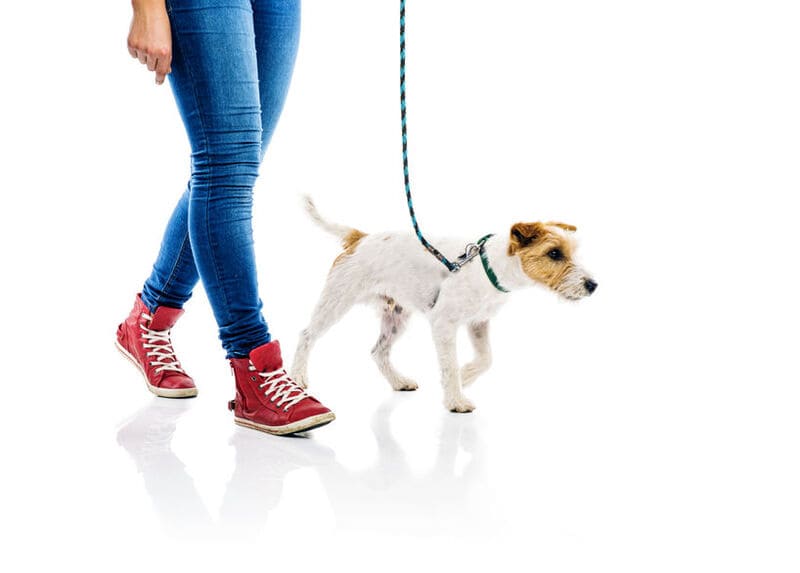
Use a leash that’s about 10-15 feet long. Cut some small-sized treats that you can use as a lure and reward. Attach the leash to the collar and lead your dog into your backyard or any place you can train him without any distractions.
Put your dog in a stationary heel position and start walking him in all sorts of directions. By this time he may already be pulling on the leash wanting to move forward.
Whenever your dog moves ahead of you, pull back on the leash and direct your body toward your dog. Walk around in a wide circle going to your left guiding him by your side and stopping right where you began.
You end in a position where your dog is standing right beside you in almost a “heel” position. There must be no pressure on the leash, and every time he assumes the right position, reward him with a treat. The goal here is to make your dog remember what the correct position is.
Repeat this exercise for as long as your dog keeps on tugging on the leash. Once he gets used to following your cues and paying more attention to you, you can move on to the next exercise
Stage 2: Use the Lure and the “Hold Your Ground” Challenge

After teaching your dog to follow you around in a circle to the left and ending in a semi-heel position, it is now time to put more emphasis on him paying more attention to you.
This exercise is done by using a lure within a stationary position. Throw a treat about 8 feet away from you and your dog. Allow him to go as far as almost reaching the treat, then stop him just right before he gets to it.
Do not let him pull through the leash and stand your ground. Avoid jerking the leash as this might hurt your dog. Chances are, your dog will look back at you and will be asking you, “What’s up?” Wait for him to walk back to you.
Mark the Action as Your Dog Comes Up to You
When he walks back to you and the leash loosens up, you will acknowledge him with “okay”, as a mark for the action. Then, move forward indicating to your dog that he can now go forward and take the treat. Make your dog remember that he gets rewarded when there is no pressure on the leash.
Keep on doing this exercise until your dog associates the reward with a leash that has no pressure.
Stage 3: Walking with your Dog in a Straight Line and Backing Up
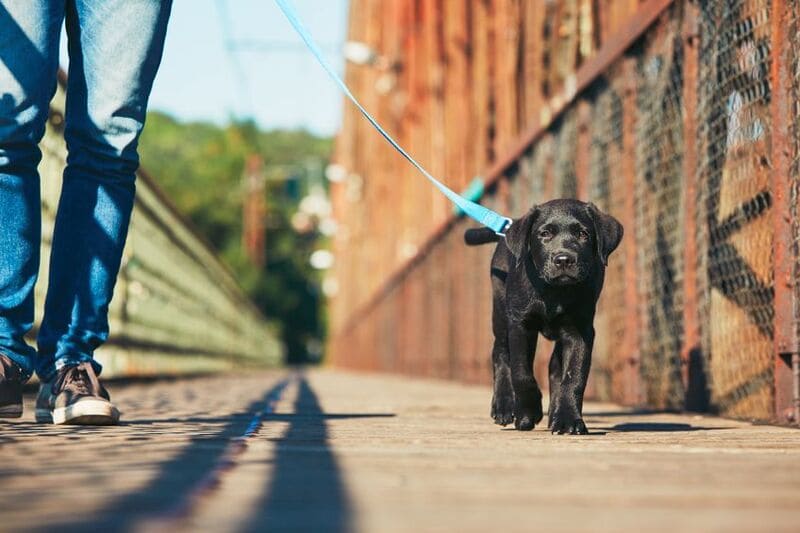
You’ve been able to establish stationary and moving leash control with your dog. It’s now time to try your dog’s leash skills outside of the house, preferably on a quiet back road. This exercise may sound simple enough, but you wouldn’t be able to walk in a straight line with your dog if you haven’t done the first two exercises.
With a dog that is still constantly lunging and pulling ahead of you, the goal is to settle down your dog and have him walk beside you.
Start walking your dog in a straight line. The moment you feel a tug or pressure on the leash immediately stop and walk back 1 or 2 steps behind. After that, with your dog backing up too, do an about-face and continue walking forward. Make sure that when you are walking forward, the leash is hanging loose. If and when he follows you on a leash with no pressure, reward your dog with verbal praise and a treat.
Stage 4: Proofing Your Dog
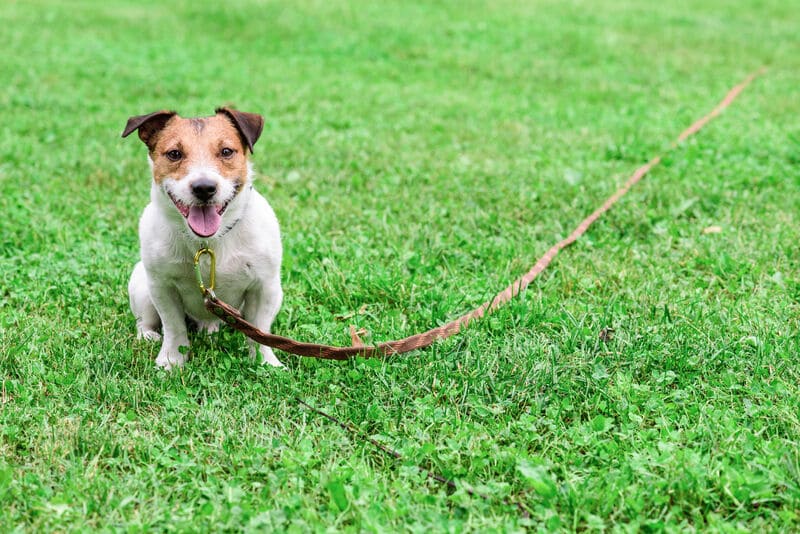
1. Practice Indoors
As you go through the previous steps of teaching your dog how to walk with a loose leash, continue doing so inside your house or your yard since this is to prepare the both of you for an outside walk. Gradually reduce the length of the leash from 15 to 6 feet
Walk the dog in the yard in all sorts of directions to get him accustomed to changing pace and keeping his attention on you. Vary the speed, and as you go along consistently reward him with treats and praise when he can keep up with you on every 2 -3 additional steps.
2. Partially Fade Treats
Before you go and proof your dog out in the streets, try weaning him off a bit from his treats – but don’t eliminate it yet. Use less food as your dog progresses with better response and attention.
Assuming that your dog has already undergone training with you for a sufficient amount of time, you can now measure your progress by how he pays attention to you. You can also check how often he stays by your side even when you don’t command him to.
Does he immediately follow your cue? Or does he still sometimes ignore you? Either way, you can adjust the treats accordingly.
3. Adding Distractions
Assuming that your dog has completed his training exercise in the backyard, he is now ready to be taken out into the street. A regular street with some average distractions will qualify as the first stage as it won’t be much of a distraction when you are going for a walk around the neighborhood and on to the nearest park.
4. Using the “Let’s Go” Command”
The “Let’s Go” command is to teach your dog to follow you when it becomes necessary to leave a place for various reasons. Given the “Let’s go” command within the right conditions, your dog should quickly turn around and follow you on cue.
5. Start by Using Treats
Call your dog by name and have him stay at your side. Hold out your hand, touch his nose, and say let’s go”, then move 2 steps forward. Your dog should follow you with no tension on the leash. When he does, give him a treat.
As your dog follows you in an ever-increasing number of steps, reward him with a treat and verbal praise every time he stays in the correct position.
If your dog doesn’t immediately turn, you can do a gentle tug on the leash to move him in the direction you are walking. Give the verbal cue “Let’s go” to your dog as soon as you step out from the yard and onto the street. If he forgets and suddenly goes after a squirrel somewhere in the bushes, quickly react by stopping (with a gentle pull on the leash) and taking two steps back. As your dog looks back at you, walk forward again.
Repeat as necessary rework your dog’s memory from house training and apply the distractions from the outside world.
6. Training Outside
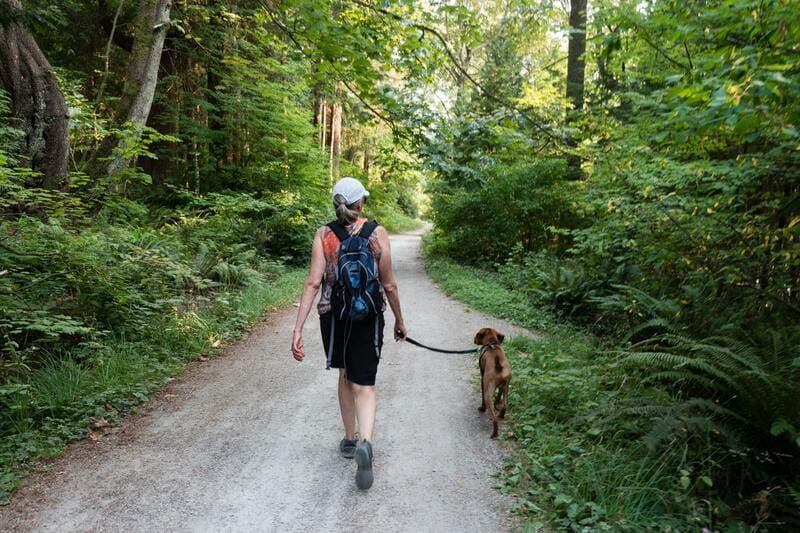
In the beginning, your dog might be confused, but if you have invested enough time into teaching him indoors, chances are his memory will spring back into action and he will likely obey the second or third time around. However, don’t expect it to be perfect as he still needs to get used to seeing other dogs and other people. And don’t forget that a low-flying bird can easily set off a well-trained dog to chase if it gets near enough.
Always let your dog know that you are the leader without being too overbearing. And every time he veers off course, you can always work a gentle tug at his leash and redirect him at any moment.
Keeping Your Dog Close
Don’t hesitate to call your dog to heel when he seems to be losing focus. It could be another dog being walked by a neighbor or some strange smell on the sidewalk that he can’t resist. Either way, you have to regain his attention.
If you notice him lagging too far behind you can check to see if your pet is alright. Other than that, a gentle call to his name or maybe a “let’s go” will get him to walk beside you. Don’t forget to reward him with a treat if he comes up and keeps up.
Too Much Distraction
There might be some instances that you will encounter loud noises like oncoming traffic, honking, and anything that may seem to bother your dog more than he can tolerate. You don’t have to force him the first time. It’s okay to take your dog out of that situation right away. Anxious dogs can become aggressive especially when their threshold for distractions goes over the limit.
Check Your Dog’s Progress
Keep repeating the training methods mentioned above for as long as needed. You will eventually need less and less resetting and reinforcing when your dog becomes more accustomed to outside stimuli. Gradually reducing treats is also recommended. The goal is a well-mannered and attentive dog who walks with you and enjoys the process. One or two treats in a leash-walking activity will remind your dog of how good he is and will encourage him to continue doing so.
Allow Your Dog to Sniff
Dogs are such curious animals that they are likely to smell anything and everything that they come across. Let your dog be himself by giving him the freedom to sniff and explore a bit. All of these things can be done within the confines of a steady leash.
He is also authorized to go potty or pee on command (“go potty”) at the moment that you will allow him to. Those little pauses during your walk in the park and along the sidewalk could be a chance for him to relieve himself. Just be ready with your poop bag.
Now, if you wish to take your dog out of the area or end his sniffing expedition, this is where the “let’s go” command comes in handy. Say the cue and he should stop what he is doing and follow the direction you are heading.
Remember: Reward your dog when he approaches you and releases the pressure on the leash. This way, he will always remember and equate a loose leash with the possibility of reward.
Read also: An Off-Leash Dog Approaches Me and My Dog |What Should I Do?
What is the Difference Between Heel Walking and Leash Walking?
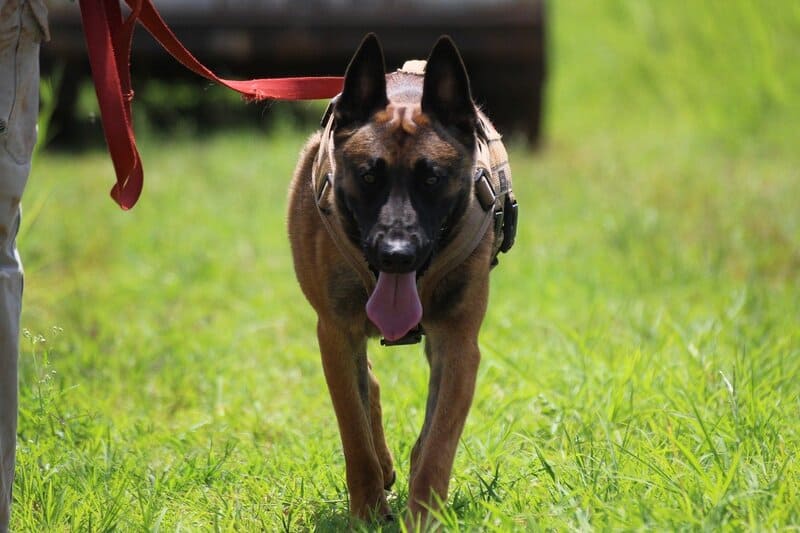
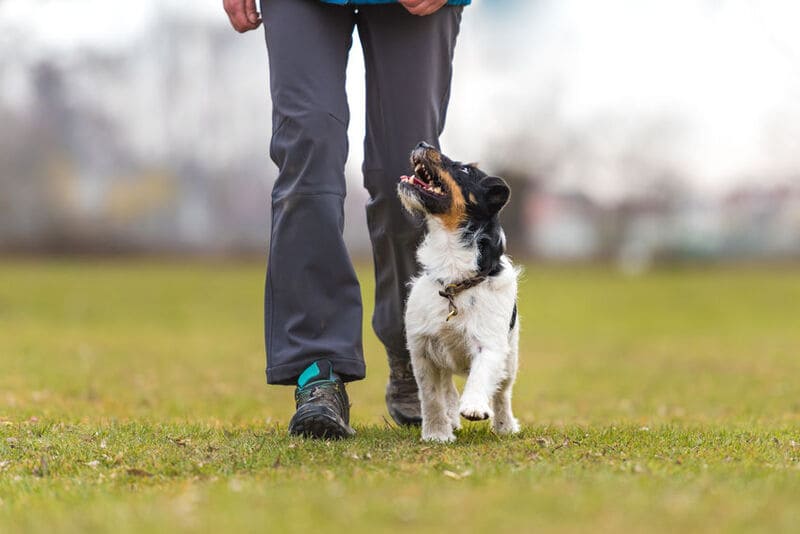
Before taking your dog outside, you must know what to expect from your dog and the exact position that you want him to assume. Don’t confuse yourself and your dog about the difference between heel and leash walking.
Heel Walking
The “heel” position means your dog has to be up close to your left or right heel, almost touching your calf. Advanced trainers practically have their dog touching their legs.
The same goes for heel walking, There has to be almost no gap between you and your dog, and your dog’s shoulders must be abreast with your thigh or leg.
See our article: How to Teach your Dog to Heel | A Step-by-Step Guide
Leash Walking
This type of walking means that you may have a longer leash and your dog doesn’t necessarily have to be right beside you. He could be a little bit farther to the left and maybe slightly ahead of you since what is important is a loose leash. With leash walking your dog has a little bit more freedom to explore his surroundings when compared to heel walking.
Puppy Leash Training
The difference between a puppy and an adult dog is their attention span. Older dogs can hold attention longer than most puppies. Being patient is recommended when working with a puppy.
How Soon Can I Start With a Puppy?
You can start acclimating your puppy with a dog collar as soon as he or she is 8 weeks old. Try putting it on him for certain periods, and at around 10-12 weeks old you can begin to teach leash walking as a fun game. While you go through the steps, try to remember that he is still a juvenile, so don’t expect too much.
What if my puppy bites the leash?
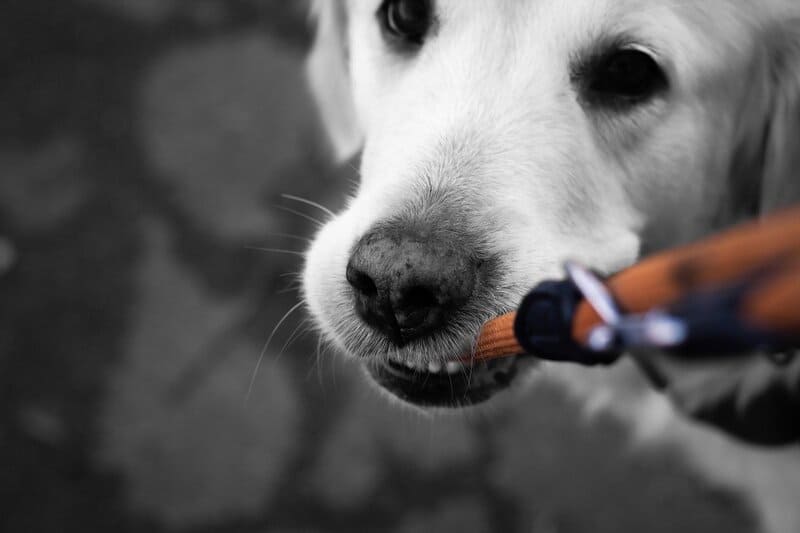
When your puppy is uncomfortable and starts chewing on the leash, here’s what you can do:
- Stop Walking
- Use a lure to shift his attention from the leash.
- Delay giving the treat.
- Distract him by making him do some other command like “stay”, “sit”, or “lie down”.
- When he follows your verbal cue reward him with a treat.
This should help your puppy or dog shift its attention from the leash to some other “job” he has to do.
Note that it’s almost the same pattern for both puppy and dog, but be prepared for the difference in reaction times and attention span. Again, puppies have shorter attention spans.
See also: How to Train Your Dog to Stop Barking at Other Dogs
My Dog Pulls Back, What Can I Do?
- Stop and stand still, do not pull back.
- Wait until the leash relaxes as your dog may be stepping backward or turning around to look at you.
- When the leash loosens up continue walking.
- Be patient and repeat the process as necessary.
The goal is to make your dog understand that every time he pulls the leash the reward stops.
Responses may vary with the type of dog, age, and surroundings. Try to make your puppy’s training funnier by sounding like it’s playtime. Patience is key. And of course, don’t forget to give them a treat when they do the correct behavior.
Can I Leash Train My Older Dog?
Yes, however, training an older dog if for anything else will take some extra patience and effort on your part since your dog will be unlearning some old habits. Resist forcing or sudden jerking.
My Older Dog is Biting on the Leash, What Can I Do?
- Use a shorter leash for quick and easy correction
- Put on the shorter training leash for at least 10-15 minutes a day to disassociate your dog from your usual long walks. This will help him prepare for something new.
What If My Dog Is Too Strong to Walk?
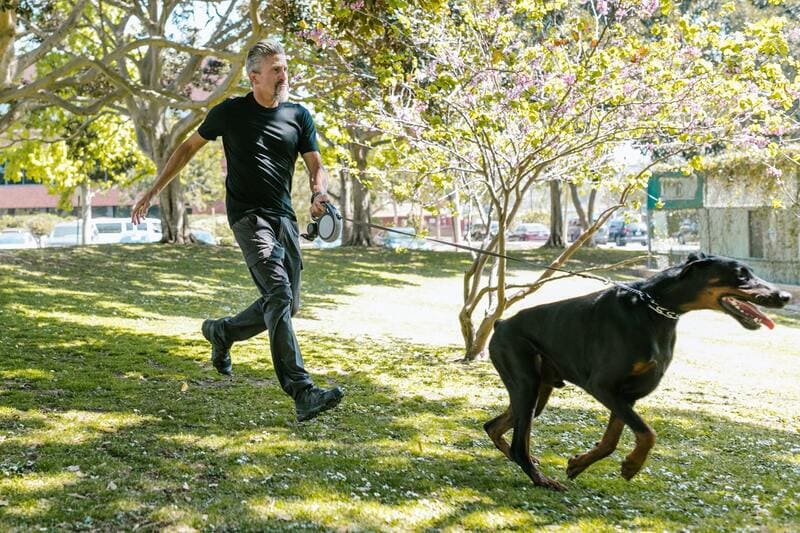
You might have a hard time implementing leash training because of your dog’s breed. Is he a Malamute? This type of breed can be hard to handle. They are mainly used to pull sleds. So, be aware and stack the odds in your favor by choosing the dog that you will want to own and train. Other options include using a thinner collar (but not too thin) and a shorter leash for more control.
A collar is more effective since it will have direct contact with your dog’s neck and he will feel some tolerable pressure on his neck when you stop. This way he will pay more attention to you.
How Do I Leash-Train My Dog Without Treats?
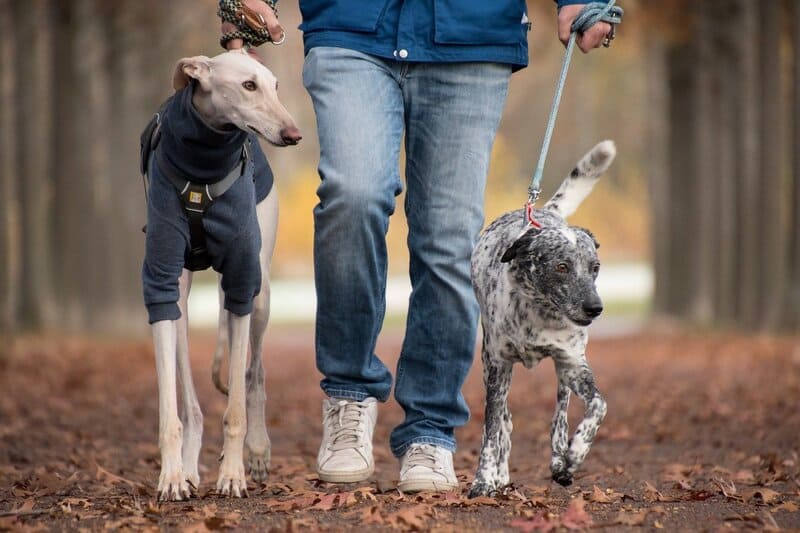
If you are an experienced trainer and have already formed years of experience and bonding with your dog, going without treats is an option. All you need is the skill and steps to train your dog using a leash, your voice, and your body language. You can guide him via a gentle tug on the leash in any direction you would like him to take.
Reinforcement by way of positive words like “good girl or good boy” and a good tone of voice is effective. When your dog learns that he can please you by walking at your pace, he will continue doing so. This kind of bond increases your dog’s attention toward you as a leader, which is important in situations of extreme distractions.
Provided that you were able to establish that bond, your dog will likely follow your command almost instantly even when faced with confusing stimuli.
Read also: How to Teach Your Dog to Stay [Step-by-Step]
Treats as a Tool for Training
Using treats as a tool for training is quite effective when properly done. However, if you depend on it too much, it leaves your dog waiting only for the treat as a reward.
We would recommend that you use treats as a back reinforcement. Keep in mind that the goal is to establish some sort of bond with your dog to keep him attentive. Establishing an alpha relationship with your dog is familiar to them since that’s how they operate in a pack.
Keeping them busy with food would leave them confused when they discover later that none is forthcoming. Sometimes your dog likes to have a leader rather than a food-dispensing human.
Training Without Treats
Talk to your dog, Provide happy satisfied verbal praises and some touch rewards like a small pat on the head. Your pet may not be as expressive but they will remember. This is similar to negative experiences like yelling at your dog in anger or maybe hitting him with a stick. They too will not forget.
An owner-pet relationship with your dog with some form of sight and sound language is a better alternative than a food-only reward. Your dog is happier and has a better attention span.
You can begin with treats as the main source of reward, especially for advanced tricks. Shortly thereafter, add the verbal praises along with the treats for a job well done. You can do this as often as your dog correctly does the command.
Somewhere along the second stage where your dog is almost in lockstep with you, you can now begin to fade out the food reward. Replace it with verbal praise or a hand signal. This is to let your dog know that he or she is doing well. As you start proofing your dog you can now keep his treats as a secondary form of reward, especially when your dog overcomes a loud distraction by keeping his attention on you.
Final Phase of Training
Continue using secondary treats as a form of backup until you observe that your dog is already in lockstep with you.
Read also: How Do You Teach a Dog to Come When Called?
Leash Walking Games
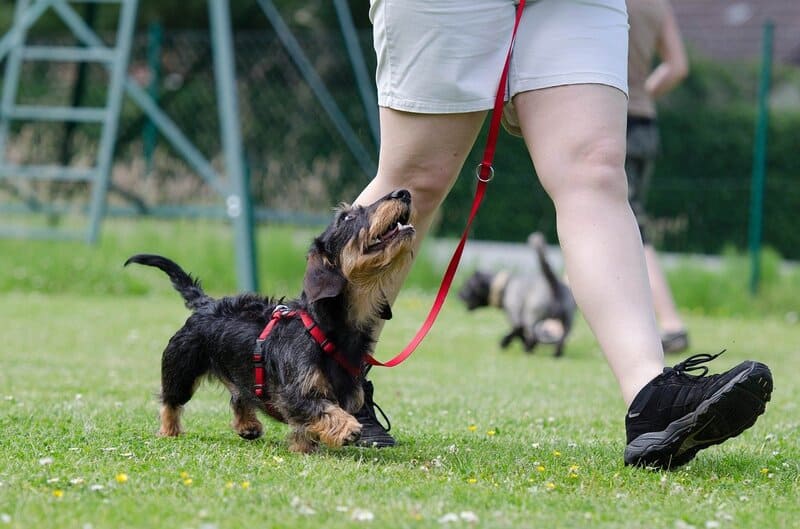
1. Heeling Game
This game rewards your dog for getting closer and closer to your left side heel in a walk. This creates a tight heeling position for your dog where he walks incredibly close to your heel and looks up at you.
It is mostly done for competition purposes but it can also benefit your dog in a way that it increases focus.
2. Treasure Hunt Game
Hide treats in different areas in the training place (not too hidden and not too obvious), then take your dog with you and point to one treat and say “Look what I found”! Your dog will excitedly take the treat and look at you for the next treasure to find. At this point, you have his complete attention for a possible find and a reward.
You can begin to use this game when you are walking outside whenever your dog is on the leash and is not pulling it. The benefit of this game is twofold: you get to increase attention, and your dog will learn to associate the excitement and reward with a loose leash.
These are just some of the examples of games that you can do with your dog that are fun and exciting.
How Long Does it Take to Teach Your Dog How to Leash Walk?
It depends on several factors: Is your dog an easy-to-train breed? How old is your dog? How much time are you willing to spend in a day?
Most owners would agree it takes about 5 minutes for your dog to learn the behavior, but it takes around 30-40 minutes to be learned as a discipline. Be prepared to spend at least 45 minutes a day or every other day for training. The good news is every day that your dog progresses you can reduce the amount of time by 5 minutes depending on the level of learning and consistency.

